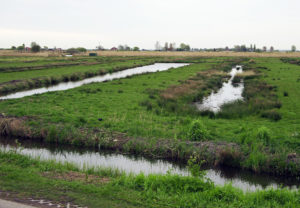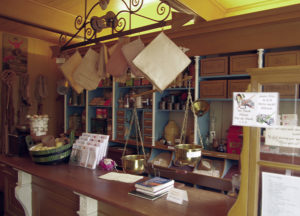I love visiting open air folk museums and this is wonderful. You really do feel as if you are stepping back in time.
This region of the Netherlands was once an important industrial area with hundreds of windmills which produced linseed oil, ground grain and spices, as well as pigments for paint and wood products. Others were used to scoop water into the dykes. Wind was the sole source of power until the steam engine took over in 1850. There were once over 10,000 windmills but now only 800 survive.
Six working windmills have been preserved along the banks of the River Zaan as part of an open air museum. Old buildings from the surrounding area have been reconstructed here as an idealised reconstruction of a typical Dutch village from the C19th, with farmsteads, wooden houses, warehouses and windmills, canals, bridges, ditches and fields. Chickens scratch in the gardens and sheep graze on common land in the village. Many of the houses are still lived in and have small gardens. Others are open as gift shops or workshops. It is a wonderful place to wander and explore.
Most of the houses are built of wood. Traditionally they were painted either black or green. The black paint was tar based and acted as a waterproof layer. Green was the cheapest colour paint available. The deeper the green, the more wealthy the house owner. In the main street there are some brick built houses. These are slightly later. Brick houses were a status symbol costing more than wood to build. They were also warmer.
The surrounding area is very wet, being reclaimed polders and is criss crossed with drainage ditches and canals crossed by the typical white wooden bridges.
This makes a fascinating day out. The windmills still work and are surrounded by the miller’s domestic buildings, including his privy which emptied direct into the river.
There is also a working clogmaker and there are regular demonstrations of clog making. There is also an exhibition of different sorts of clogs, including those with broad flat soles used for peat cutting or clogs with metal spikes for walking on frozen canals. There were even clogs for cows and horses. Clogs make a popular gift and this is an excellent place to buy them.
The cheese factory is immediately recognisable by the milk churns outside and again there are regular demonstrations of cheese making. Behind is a huge shop selling a wide range of different cheeses, with samples to try.
The bakery dates has a small tea room attached and sells bread, pastries and biscuits. According to the website, it features an ‘authentic bread baking oven’ although this also comes with a modern microwave…
Barrels were important for storing everything from beer and wines to butter, fish and fruits. Every town would have a cooperage and there is one here too.
In the main street is the grocery shop of Albert Heijn which opened in 1887, complete with all the original fittings. He later went on to found the Ahold supermarket chain.
The Zaanse Museum gives an historical overview of the people and industry of the area. we didn’t have time to visit this.
Do allow plenty of time to visit – several hours if possible. The site does get very busy so plan to arrive early. Entry to the site is free but there is a charge to go into many of the buildings. Entry to the windmills is €4. Depending on what you are wanting to see, it might make sense to buy a “Zaanse card.”:https://www.dezaanseschans.nl/en/plan-your-visit/zaanse-schans-card/ This gives free entry to one windmill with 50% of a second windmill, plus other benefits.
Also make sure you have 50c for the toilets…
Not everything is open everyday. There is a “calendar”:https://www.dezaanseschans.nl/en/plan-your-visit/ on the website listing what is open and when. Be warned the websites are designed to be viewed on a smart phone rather than computer.
For those wanting it, there is a free audio guide available from the museum desk. There is also a photographer on the main bridge as you enter. He takes pictures of everyone which are then included on the front of a Zaanse Schans calendar which you can buy on your way out.
Do remember your camera. This is a very photogenic place. It was a damp and very murky day when we visited, and the photographs do have a Bruegel quality to them. There are a lot more pictures “here.”:http://wasleys.org.uk/eleanor/otherholidays/holland/day_three/index.html










